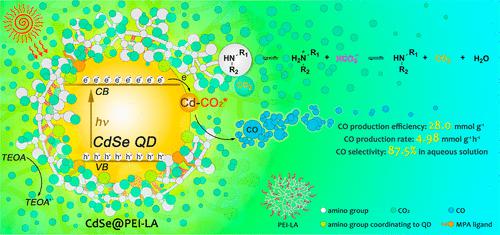当前位置:
X-MOL 学术
›
ACS Appl. Mater. Interfaces
›
论文详情
Our official English website, www.x-mol.net, welcomes your
feedback! (Note: you will need to create a separate account there.)
Assembling CdSe Quantum Dots into Polymeric Micelles Formed by a Polyethylenimine-Based Amphiphilic Polymer to Enhance Efficiency and Selectivity of CO2-to-CO Photoreduction in Water
ACS Applied Materials & Interfaces ( IF 8.3 ) Pub Date : 2022-06-24 , DOI: 10.1021/acsami.2c07656 Jin Wu 1 , Bo-Yi Deng 1 , Jing Liu 1 , Si-Rui Yang 2 , Ming-De Li 2 , Jing Li 3 , Feng Wang 1
ACS Applied Materials & Interfaces ( IF 8.3 ) Pub Date : 2022-06-24 , DOI: 10.1021/acsami.2c07656 Jin Wu 1 , Bo-Yi Deng 1 , Jing Liu 1 , Si-Rui Yang 2 , Ming-De Li 2 , Jing Li 3 , Feng Wang 1
Affiliation

|
Colloidal quantum dots (QDs) as photocatalysts enable catalysis of CO2-to-CO conversion in the presence of electron donors. The surface and/or interfacial chemical environment of the QDs is essential for the activity and selectivity of the CO2 photoreduction. Various strategies, including exposing active metal sites or anchoring functional organic ligands, have been applied to tune the QDs’ surface chemical environment and thus to improve both activity and selectivity of CO2 photoreduction, which occurs at surface of the QDs. However, the efficient and selective photocatalytic CO2 reduction with QD photocatalysts in water is still a challenging task due to low CO2 solubility and robust competing reaction of proton reduction in water. Different from state-of-the-art QDs’ surface manipulation, we proposed to ameliorate the interfacial chemical environment of CdSe QDs via assembling the QDs into functional polymeric micelles in water. Herein, CdSe@PEI-LA assemblies were constructed by loading CdSe QDs into polymeric micelles formed by PEI-LA, a polyethylenimine (PEI)-based functional amphiphilic polymer. Due to self-assembly and high CO2 adsorption capacity of PEI-LA in water, the photocatalytic CO2-to-CO conversion efficiency and selectivity of the CdSe@PEI-LA assemblies in water were dramatically improved to 28.0 mmol g–1 and 87.5%, respectively. These two values increased 57 times and 1.5 times, respectively, compared with those of the pristine CdSe QDs. Mechanism studies revealed that CdSe QDs locate in polymeric micelles of high CO2 local concentration and the photoinduced electron transfer from the conduction band of CdSe QDs to Cd–CO2* species is thermodynamically and kinetically improved in the presence of PEI-LA. The CdSe@PEI-LA system represents a successful example of using a functionalized amphiphilic polymer to ameliorate interfacial microenvironments of nanocrystal photocatalysts and realizing efficient and selective CO2 photoreduction in water.
中文翻译:

将 CdSe 量子点组装到由基于聚乙烯亚胺的两亲聚合物形成的聚合物胶束中,以提高水中 CO2 到 CO 光还原的效率和选择性
作为光催化剂的胶体量子点 (QD) 能够在电子供体存在的情况下催化 CO 2到 CO 的转化。量子点的表面和/或界面化学环境对于 CO 2光还原的活性和选择性至关重要。各种策略,包括暴露活性金属位点或锚定功能性有机配体,已被应用于调节量子点的表面化学环境,从而提高发生在量子点表面的CO 2光还原的活性和选择性。然而,由于低CO 2 ,在水中使用QD光催化剂进行高效和选择性的光催化CO 2还原仍然是一项具有挑战性的任务。质子在水中还原的溶解度和强烈的竞争反应。与最先进的量子点表面处理不同,我们提出通过将量子点组装成水中的功能性聚合物胶束来改善 CdSe 量子点的界面化学环境。在此,CdSe@PEI-LA组件是通过将 CdSe 量子点加载到由PEI-LA 形成的聚合物胶束中来构建的,PEI-LA是一种基于聚乙烯亚胺 (PEI) 的功能性两亲聚合物。由于PEI-LA在水中的自组装和高 CO 2吸附能力,CdSe@PEI-LA的光催化 CO 2转化为 CO 的效率和选择性水中的组装量分别显着提高到 28.0 mmol g –1和 87.5%。与原始 CdSe 量子点相比,这两个值分别增加了 57 倍和 1.5 倍。机理研究表明,CdSe QDs 位于高 CO 2局部浓度的聚合物胶束中,并且在PEI-LA存在下,从 CdSe QDs 的导带到 Cd-CO 2 * 物质的光诱导电子转移在热力学和动力学上得到改善。CdSe@PEI-LA系统是使用功能化两亲聚合物改善纳米晶光催化剂界面微环境并实现高效选择性CO 2的成功范例水中的光还原。
更新日期:2022-06-24
中文翻译:

将 CdSe 量子点组装到由基于聚乙烯亚胺的两亲聚合物形成的聚合物胶束中,以提高水中 CO2 到 CO 光还原的效率和选择性
作为光催化剂的胶体量子点 (QD) 能够在电子供体存在的情况下催化 CO 2到 CO 的转化。量子点的表面和/或界面化学环境对于 CO 2光还原的活性和选择性至关重要。各种策略,包括暴露活性金属位点或锚定功能性有机配体,已被应用于调节量子点的表面化学环境,从而提高发生在量子点表面的CO 2光还原的活性和选择性。然而,由于低CO 2 ,在水中使用QD光催化剂进行高效和选择性的光催化CO 2还原仍然是一项具有挑战性的任务。质子在水中还原的溶解度和强烈的竞争反应。与最先进的量子点表面处理不同,我们提出通过将量子点组装成水中的功能性聚合物胶束来改善 CdSe 量子点的界面化学环境。在此,CdSe@PEI-LA组件是通过将 CdSe 量子点加载到由PEI-LA 形成的聚合物胶束中来构建的,PEI-LA是一种基于聚乙烯亚胺 (PEI) 的功能性两亲聚合物。由于PEI-LA在水中的自组装和高 CO 2吸附能力,CdSe@PEI-LA的光催化 CO 2转化为 CO 的效率和选择性水中的组装量分别显着提高到 28.0 mmol g –1和 87.5%。与原始 CdSe 量子点相比,这两个值分别增加了 57 倍和 1.5 倍。机理研究表明,CdSe QDs 位于高 CO 2局部浓度的聚合物胶束中,并且在PEI-LA存在下,从 CdSe QDs 的导带到 Cd-CO 2 * 物质的光诱导电子转移在热力学和动力学上得到改善。CdSe@PEI-LA系统是使用功能化两亲聚合物改善纳米晶光催化剂界面微环境并实现高效选择性CO 2的成功范例水中的光还原。











































 京公网安备 11010802027423号
京公网安备 11010802027423号